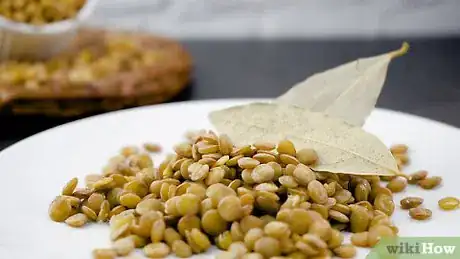This article was co-authored by wikiHow staff writer, Janice Tieperman. Janice is a professional and creative writer who has worked at wikiHow since 2019. With both a B.A. and M.A. in English from East Stroudsburg University, she has a passion for writing a wide variety of content for anyone and everyone. In her free time, you can find her working on a new crochet pattern, listening to true crime podcasts, or tackling a new creative writing project.
There are 22 references cited in this article, which can be found at the bottom of the page.
The wikiHow Video Team also followed the article's instructions and verified that they work.
This article has been viewed 15,005 times.
Learn more...
Lentils are a hearty, delicious, and meat-free option to consider for your meals. While plain on their own, these legumes can be prepared in many ways. When preparing a fancier dish, you can season your lentils with a variety of herbs, spices, and other foods. Figure out what flavors you like in order to make your lentil dishes as delicious and varied as possible!
Steps
Adding Different Herbs
-
1Use a bay leaf to add a slight mintiness to your lentils. Don’t mistake bay leaves for your run-of-the-mill fallen leaf. While a more unconventional seasoning method, bay leaves are a subtle but effective way to add a soft, mint-esque flavor to your food. Some people also think that bay leaves give off a pine-like flavor.[1]
- These are best used when seasoning soups or stews, since they have to be removed before the lentil dish is served.
- Add 1 bay leaf per 2 cups (400 g) of dry lentils.[2]
-
2Include rosemary to give your lentils a woodsy flavor. Add an earthier element to your lentils by sprinkling some fresh or dried rosemary over them. Rosemary is especially potent when making lentil stews and soups, since the flavor gets stronger when the rosemary is left to simmer for longer. If you don’t want to use it as a seasoning ingredient, consider using rosemary as a garnish for your lentils.[3]
- Don’t overdo it with rosemary. Even if you love the flavor in your lentils, start with a small amount before adding in anymore.
- Add 2 tsp (1.12 g) of freshly chopped rosemary for every 1 cup (200 g) of lentils you include.[4]
Advertisement -
3Add oregano to give your lentils a slight lemony taste. Try using oregano to add an element of citrus into your lentil recipes. Although viewed as one herb, oregano actually has 2 popular strains: Mexican and Mediterranean. For lentils, opt for the Mexican variety, as it sports a sharper, lemony taste.[5]
- Mediterranean oregano tastes different depending on the exact place it originates from. For example, Italian oregano doesn’t pack as much of a punch as Turkish oregano.
- Use 1 tsp (1 g) of dried oregano for every 2 cups (400 g) of lentils you include in the recipe.[6]
-
4Opt for dill to make your lentils taste fresh and clean. Include a special tang in your lentil dishes by using some fresh or dried dill. While well known for its use in potato dishes, try freshening your lentils with this herb instead.[7]
- If you’re planning on making a lentil dip, consider including a pinch of dill for a fun punch of flavor![8]
-
5Put in some chives to add some onion flavor. Set the stage for a sharper flavor palette by including chives. This herb allows you to experiment with onion flavors without as much of the difficult (and sometimes tearful) kitchen prep. If you’d rather not use chives in your lentil recipes, consider using them as a decorative garnish.[9]
- If you’re using an especially dense ingredient (i.e, a hearty cheese) with your lentils, try balancing it out with some chives.
Using a Variety of Spices
-
1Use cumin if you want your lentils to taste robust and smoky. Incorporate some of the flavors of Indian cuisine into your lentils by using cumin. Although it looks fairly unassuming in its container, cumin adds a smoky punch to most dishes it’s included with, including lentils. Opt to purchase cumin in ground form if you’re planning on using it to season your lentils frequently.[10]
-
2Try using coriander to incorporate a lemon-esque taste in your lentils. Add coriander if you’d prefer to use subtler spices in your cooking. While often a partner-in-crime with cumin in many recipes, the light, slightly sour elements of coriander help to take the edge off of stronger spices, like cumin. When you go to the grocery store, keep in mind that coriander is sold in both seed and powder form.[13]
- Before turning it into a powder, roast coriander while it’s still in seed form. This adds more flavor and to the spice when you add it to your lentils.
- Aside from cumin, coriander is often paired with turmeric powder, as well.[14]
- Add 1 tsp (1.8 g) of ground coriander for every cup (200 g) of lentils you use in a recipe.
-
3Add color and flavor to your lentil dishes with paprika. Don’t forget about paprika—although it’s not as obvious as cumin or other potent spices, paprika still plays an important role in the seasoning process. Unlike most neutral-toned spices, paprika can add a bit of color to your lentils. Overall, it’s definitely not pungent, but it serves as an excellent garnish for many foods.[15]
- Although it’s almost always seen in powder form, paprika originally comes from a pod. Use about 1 tbsp (6.9 g) for each cup (200 g) of dried lentils included.
-
4Include cinnamon in savory lentil dishes to have an extra layer of flavor. Open your mind to the possibilities that cinnamon can offer to your lentil dishes. Although associated with sweet foods, cinnamon can also have a more savory flavor when used in the proper context, like curries or lentil dishes. If you’re making a soup or stew, consider letting a cinnamon stick simmer in the lentils during the cooking process.[16]
- Make sure that you keep all of your cinnamon away from the heat in a dark cabinet.
- Add ½ tsp (2 g) of cinnamon into your recipe for every ¾ cup (75g) of lentils included.[17]
-
5Insert some spice into your lentils with cayenne pepper. Add cayenne pepper if you want to include a little fire in your lentil dishes. While lentils don’t have a sharp, powerful flavor on their own, cayenne pepper helps add some personality when used as a seasoning.[18]
- Unless you have a high spice tolerance, use cayenne pepper sparingly. Start by using ½ tsp (0.9 g) of cayenne pepper for every cup of lentils included in the recipe.[19]
Mixing in Other Foods
-
1Add garlic cloves for a sharp, tangy taste. Use garlic in mashed, minced, or whole form to add a sharp and savory flavor to your lentils. While garlic on its own can be pretty overpowering, small amounts can help season your lentil dishes and take them to the next level. Make sure that garlic cloves you use aren’t too old. If a green stem is visible inside of each clove, consider switching to a new bulb.[20]
- If you plan on using garlic a lot, consider investing in a garlic clove presser.
-
2Use lemons to add a zing to your lentil dishes. Add lemon juice or rind to add a subtle sourness to your lentils. Aside from giving your dishes a boost of vitamin C, lemon juice helps appeal to your sour palette. Lemons (and lemon juice) are a great ingredient to have on hand, as they work in a wide variety of recipes.[21]
- For example, a Moroccan spiced lentil soup uses lemon juice for a more subtle flavor, as opposed to the wide variety of other spices that the recipe calls for.[22]
-
3Include some raw ginger to add a little spice to your lentils. Break the sweet flavor barrier by seasoning your lentils with fresh ginger. Overall, ginger is an incredibly versatile cooking ingredient—while it comes powdered, some of its greatest flavors come to light while it’s still fresh. Depending on the recipe, you might be dicing or mincing the fresh ginger. Regardless, it’s sure to add a sweet, tangy after though to your lentil dishes![23]
- Even though its associated with Asian cuisine, fresh ginger root can be found at most grocery stores.
-
4Mix in some onions to add a sharp flavor to your lentil recipes. Chop or dice some onions to include in your lentil dishes for a subtly sharp flavor. Since onions aren’t as potent as garlic, you can sue them more liberally in your recipes. Play around with different types of onions, like vidalia or red, until you find your favorite![24]
- Onions are also known to have heart benefits, and are also a great way to include antioxidants in your meals!
Things You’ll Need
Adding Different Herbs
- Bay leaves
- Rosemary
- Oregano
- Dill
- Chives
Using a Variety of Spices
- Cumin
- Coriander
- Paprika
- Cinnamon
- Cayenne pepper
Mixing in Other Foods
- Garlic cloves
- Lemons
- Ginger
- Onions
References
- ↑ https://www.bonappetit.com/story/bay-leaves-taste
- ↑ https://www.allrecipes.com/recipe/13978/lentil-soup/
- ↑ https://www.thekitchn.com/inside-the-spice-cabinet-rosemary-93261
- ↑ https://www.halfyourplate.ca/recipe/rosemary-lentil-soup/
- ↑ https://www.thekitchn.com/whats-the-difference-mediterra-93923
- ↑ https://www.allrecipes.com/recipe/13978/lentil-soup/
- ↑ https://www.epicurious.com/ingredients/fresh-herbs-how-to-use-them-article
- ↑ https://www.onegreenplanet.org/vegan-food/delicious-ways-to-eat-lentils/
- ↑ https://www.epicurious.com/ingredients/fresh-herbs-how-to-use-them-article
- ↑ https://www.thekitchn.com/inside-the-spice-cabinet-cumin-67449
- ↑ https://www.acedarspoon.com/moroccan-red-lentil-soup/
- ↑ https://www.lentils.org/recipe/indian-spiced-lentils/
- ↑ https://www.thekitchn.com/inside-the-spice-cabinet-coriander-105794
- ↑ https://www.meatlessmonday.com/recipes/coriander-lentils-over-basmati-rice/
- ↑ https://www.thekitchn.com/whats-the-difference-hot-sweet-68134
- ↑ https://www.thekitchn.com/inside-the-spice-cabinet-cinnamon-115560
- ↑ https://www.lentils.org/recipe/sweet-cinnamon-cardamom-spiced-lentils/
- ↑ https://www.bonappetit.com/story/types-of-lentils
- ↑ https://minimalistbaker.com/saucy-moroccan-spiced-lentils/
- ↑ https://www.chatelaine.com/food/kitchen-tips/how-to-cook-with-garlic/
- ↑ https://www.epicurious.com/ingredients/how-to-use-lemon-juice-to-finish-a-dish-recipes-article
- ↑ https://www.acedarspoon.com/moroccan-red-lentil-soup/
- ↑ https://www.finecooking.com/article/cooking-with-fresh-ginger
- ↑ https://www.livescience.com/45293-onion-nutrition.html
- ↑ https://www.npr.org/sections/thesalt/2012/09/14/161057954/love-to-hate-cilantro-its-in-your-genes-and-maybe-in-your-head























































